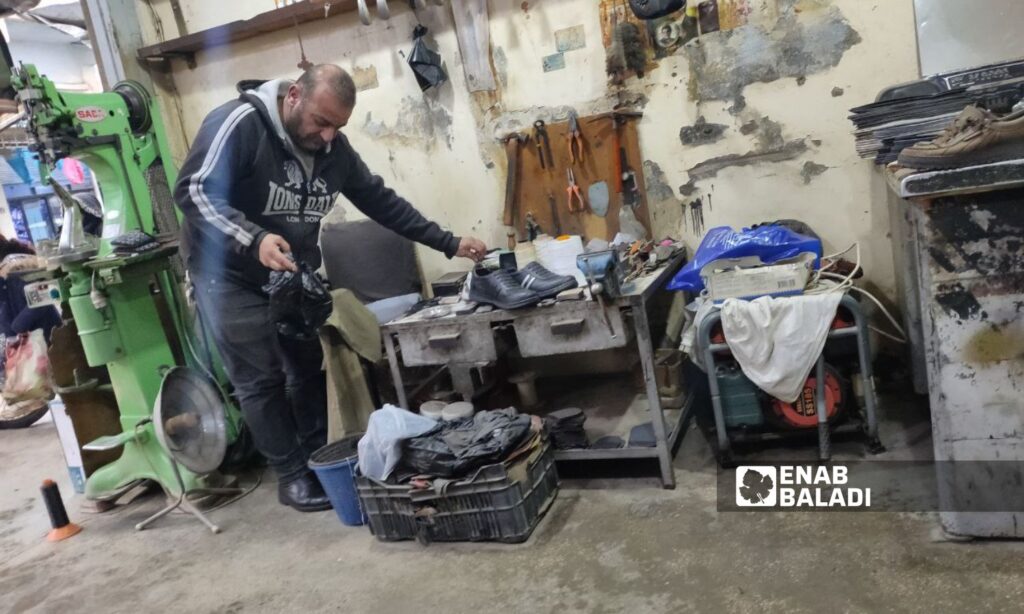Al-Hasakah – Majd al-Salem
Very early, Dany Sheikho (40 years old), a resident of Qamishli, opens the door of the shoe repair shop where he has been working for several years, to welcome customers, who usually are of modest incomes and suffer from difficult financial and living conditions.
Sheikho told Enab Baladi that he has settled in his profession for a long time amidst a growing influx of residents to repair their shoes instead of replacing them with new ones, which increases the income he makes from this profession.
Owners of shoe repair shops are used to being the first to open their shops in the market early because most of the customers are from the rural areas who come to the city early and return quickly. The nature of their work in agriculture and other labor demands renewing their footwear, according to Sheikho.
But at present, according to Sheikho, the majority of the segments from various areas, whether rural or urban, repair their shoes due to rising prices and limited income, rendering them unable to afford new necessities such as clothing and shoes.
He mentioned that piles of shoes are accumulated in some repair shops.
Regarding the fees for repairing shoes, he said they are reasonable and consider the difficult financial situation of the residents. Sewing the whole shoe (a complete wrap-around) costs 5,000 Syrian pounds, heel replacement is about 6,000 pounds, and sole replacement is around 10,000 Syrian pounds. The costs vary if the shoe is for a child or an elderly person.
New shoes also
Cobbler Dany Sheikho said that it is no longer just about fixing old shoes. People also come after buying new shoes to have them stitched or “nailed at the bottom” as a way of “reinforcement” to preempt any damage that might affect the shoes and to extend their lifespan as much as possible.
He explained that some customers bring their own and their children’s shoes all at once for maintenance, especially during the winter, when the demand increases due to the spread of water pools and mud, which expose flaws in the shoe.
The cobbler pointed out that as shop owners, they are forced to raise their prices whenever the value of the Syrian pound decreases and electricity prices increase. They mainly rely on electricity to operate the sewing machines for shoes, noting that it requires a subscription for a number of “amperes” (at least 5 amperes per month, with the price of one ampere at 20,000 pounds).
“Ampere” is a well-known local name for generator electricity in Syria, which citizens rely on in light of the electricity cuts in various Syrian regions. Its price is linked to the price of diesel, as the owners of electric generators depend on it to operate the generators.
As observed by Enab Baladi, shoe repair shops are experiencing crowdedness and high demand. There is hardly a shoe repair shop in the city of Qamishli without a number of customers sitting waiting for their shoes to be repaired.
A pair of new shoes equals half a salary
“Imagine that a pair of shoes costs half my salary,” said Ibrahim al-Fatah (49 years old), from the countryside of al-Jawadiyah, who is an employee, expressing his indignation at the rising prices that affected most essentials of life.
He said that buying a new pair of shoes every few months has become a kind of luxury. Therefore, he, like many others with limited income and the poor from the area, try to keep their shoes in a usable condition for as long as possible.
He explained that buying new shoes for his family of five costs about one million Syrian pounds, so it is better to repair them at a cost not exceeding 20,000 Syrian pounds per pair, as even used European shoes are considered expensive, and some are sold in dollars from 10 to 25 dollars per pair.
Enab Baladi monitored the prices of shoes in several shops within the city of Qamishli, ranging between 100,000 and about 400,000 Syrian pounds, depending on the type and quality of the shoe.
The minimum wage in northeastern Syria is about one million Syrian pounds (USD 68), after the Autonomous Administration of North and East Syria (AANES) raised salaries in August 2023.
Shalan Mohammed (20 years old), a worker in a shoe store, told Enab Baladi that the demand for buying shoes is “below average,” except for the good turnout during holiday periods.
He added that the stores try to stimulate sales through offers and discounts, but the prices remain high for consumers.
He mentioned that most of the displayed goods are of Turkish origin, entering through the Semalka crossing. They cost a lot to arrive due to the high levies, taxes imposed, and shipping expenses.

